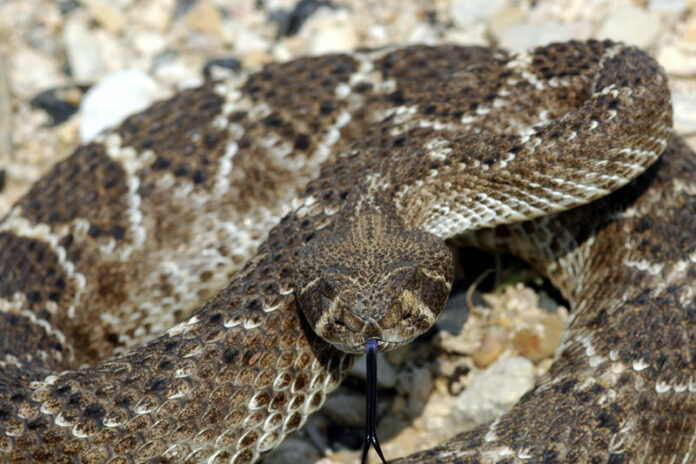As expected, this year has seen a dramatic increase in rattlesnake sightings, encounters and even bites, and it is far from over. Rattlesnake Avoidance Training for Dogs is back by popular demand.
If you enjoy activities that take you and your dogs outdoors, you and your pets may be at risk for encountering rattlesnakes. And as the snakes move along in search of food and mates, they may even end up in your own backyard.
“I’d say that most dog owners don’t really think about snake bites until they see a rattlesnake for themselves, in parks or their backyards, and then realize their dogs can be at risk,” says John Potash, owner of Get Rattled. He adds, “Get Rattled is a unique training clinic designed specifically to teach dogs to recognize and avoid the sight, sound, and smell of rattlesnakes. We have been teaching this clinic for over 15 years and have successfully trained thousands of dogs.”
Potash is licensed by the Nevada Department of Wildlife and says he has over 25 years of experience working with venomous snakes and wildlife in areas of animal control, wildlife rescue and public education. He works with a team of trained and experienced dog handlers and trainers with decades of combined experience in a variety of training and handling methods to offer you and your dogs the best quality training in a safe and secure environment.
Rattlesnake Avoidance Training is a crucial tool for dog owners. Potash says, “Prevention is your number one line of defense in protecting your dogs from venomous snakes. When dogs and their owners go hiking or to the dog parks to go off leash, this training teaches them to be fearful of the rattlesnake. It protects people as well, as the dog becomes an alert system. This training has proven to be an effective tool in teaching rattlesnake avoidance to all dogs from Great Danes to Chihuahuas.”
Because rattlesnakes can regulate the amount of venom they inject into another animal; the health risks to dogs from a bite can vary greatly depending on the amount of venom injected, the species and size of rattlesnake and the size of the dog and where it was bitten. Dogs can also be bitten when owners are not around, so Potash suggests that people know some general signs of a bite along with health risks: “Dogs are usually bitten on their limbs, neck, head, or face so look for severe swelling in those areas. After some time, the venom may produce nausea, vomiting and the dog can seem lethargic and will begin to act as if something is bothering them. If you see a snake bite happen or notice these symptoms, keep your dog calm and take them to a vet right away. It’s always better to be safe than sorry.”
Sonoma County pet owners are encouraged to take part in this important Rattlesnake Avoidance Training Clinic. Vintage Kennel Club is hosting a training session in Sonoma on August 5. Trainings are provided by appointment with sessions lasting approximately 20-30 minutes. Costs for the training are $85 per dog or $60 for refresher training. This clinic will provide local dog owners extra assurance and peace of mind that their dogs will avoid dangerous rattlesnake encounters, protecting their health, and their families from suffering the pain and medical costs of a rattlesnake bite.
To register or for more information, please contact Vintage Kennel Club at 707-938-1173,
do*********@ao*.com
or Get Rattled at 775-234-8844, Http://GetRattled.Org.








